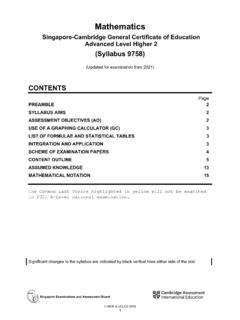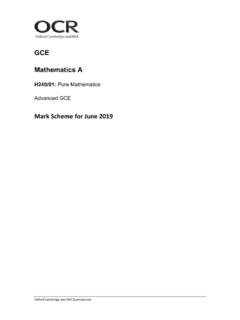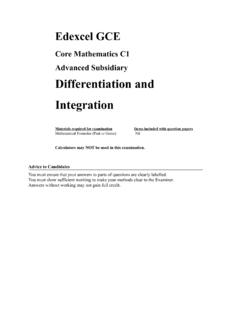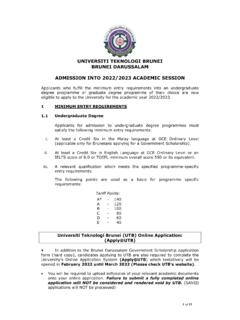Transcription of Science, Technology, Engineering and Mathematics (STEM): A ...
1 World Journal of education Vol. 6, No. 5; 2016 Published by Sciedu Press 27 ISSN 1925-0746 E-ISSN 1925-0754 Science, Technology, Engineering and Mathematics (STEM): A Case Study of Zimbabwe s Educational Approach to Industrialisation Hardy Chitate1,* 1 Department of Curriculum and Arts education , Faculty of education , University of Zimbabwe, Harare, Zimbabwe *Correspondence: Department of Curriculum and Arts education , Faculty of education , University of Zimbabwe, Harare, Zimbabwe. E-mail: Received: August 12, 2016 Accepted: September 1, 2016 Online Published: September 22, 2016 URL: Abstract One of the fundamental pre-requisites for Industrialisation is its stupendous availability, in a country of skilled-manpower.
2 In this regard, Zimbabwe has sought to leverage human resources, such as these, in order to accelerate the process of socio-economic transformation. In March 2012, for example, the Government of Zimbabwe (GoZ) pronounced the Second Science, Technology and Innovation Policy framework, which provided the two Ministries of Primary and Secondary education and Higher and Tertiary education , Science and Technology Development with the opportunity to implement the relevant spellings out of that policy document. The former launched an update review of the national curriculum, in 2014, which culminated, in the crafting of the Zimbabwe education Blueprint (2015-2022).
3 That education -design plan has many facets. Chief among them is a deliberate emphasis on the teaching of Science, Technology, Engineering and Mathematics , subjects that are now known popularly by the acronym STEM . Classroom instruction, in those disciplines is meant to empower students with the cutting-edge skills that should see them participate actively, in both the local and global economies. The latter Ministry has rolled out the new STEM curriculum at the advanced level, in January 2016. Through documentation analysis, this paper, therefore, attempts to unpack the new curricular innovation (STEM), that Zimbabwe has devised most recently as one of her very best policy strategies towards achieving industrial development, in the foreseeable future.
4 Keywords: curriculum; education and training; industrialisation; innovation; vocational and technical skills 1. Introduction The turn of the century made Industrialisation the Holy Grail of many African countries, including Zimbabwe. For instance, the former chair of the Southern Africa Development Community (SADC) and the African Union (AU), His Excellency, the President and the Commander-in-Chief of the Defence Forces of the Republic of Zimbabwe, Comrade Robert Gabriel Mugabe, has envisaged the full Industrialisation of the continent by the year 2063. Consequently, regional groupings, such as SADC to, which Zimbabwe is a member state, are, in the process of drawing up elaborate roadmaps for economic development.
5 To date, SADC has produced a draft Regional Industrialisation Strategy and Roadmap that provides a framework for major economic and technological transformations at the national and regional levels within the context of deepening regional integration (Ngwawi, 2015: 1). The primary focus of this strategy, whose chief aim is to exploit the comparative and competitive advantages of the region, is the ultimate attainment of Industrialisation, regional integration and economic competitiveness (Ngwawi, 2015). To complement the SADC industrial initiative, the Government of Zimbabwe enunciated, in 2013, a new five-year economic blueprint called, Zimbabwe Agenda for Sustainable Socio-Economic Transformation (October 2013-December 2018) , in short, Zim Asset with a vision, Towards an Empowered Society and a Growing Economy.
6 In the words of Mugabe (2013: 1) Zim Asset was crafted to achieve sustainable development and social equity anchored on indigenization, empowerment and employment creation, which will be largely propelled by the judicious exploitation of the country s abundant human and material resources. The results-based agenda seeks to stimulate economic growth and the creation of wealth through its four strategic clusters, namely: Food, Security, and Nutrition , Social Services and Poverty Reduction , Infrastructure and Utilities as well as Value Addition World Journal of education Vol.
7 6, No. 5; 2016 Published by Sciedu Press 28 ISSN 1925-0746 E-ISSN 1925-0754 and Beneficiation . The constraints of space do not permit a full examination of the above mentioned clusters. However, what is of most particular interest, in this academic discourse is to show how Zimbabwe has attempted to use education as an instrument for change of the Social Services and Poverty Reduction cluster to achieve her economic goals. The climax of the paper is an assessment of the potential challenges, prospects and benefits of that new developmental trajectory. education Development, in the Post-Independent Zimbabwe The colonial epoch, in Zimbabwe from 1890 to 1979 witnessed the development of an education system that was elitist, in its deliberate bias; and was marked by exclusively limited access and facilities, as well as lack of relevance.
8 It was against this background, combined with the pressing socio-economic demands of the Zimbabweans, which triggered the need for radical change, in education when the country eventually won political freedom from the then white-minority British colonial masters on the 18th of April 1980. The first decade of political Independence, therefore, saw the main thrust of the new nation s post-colonial re-construction efforts being directed at the mass-improvement of educational access and equity, together with bringing the content, methods and assessment of education , in line with the existing African conditions, the postulate of national Independence and the imperatives of balanced economic development.
9 The education Secretary Report (1980-1987) quoted, in Nziramasanga (1999: 9), for example, notes: In 1979, there were 2 401 primary schools enrolling 81 958 pupils learning in segregated schools, but ten years later primary schools had increased to 4 504, enrolling in excess of 2 274 178 pupils. At secondary school level, there were 177 schools in 1979 with a student population of 66 215. Ten years later, the secondary schools had increased to 1 502 with an enrolment of 695 882 students. The net-result of the Government s educational policy intervention measures has been the development of a strong human resource base, which gives Zimbabwe a comparative advantage over regional and other international countries (Zim Asset, 2013).
10 At present, the country has a staggering literacy level of ninety-two percent, which ranks the highest, in Africa. Zimbabwe, therefore, has every reason to look at her many highly academically-qualified citizens who are working, in foreign countries today with evident pride. Some of these workers occupy jobs, in companies or organisations associated with the commanding heights, in the economies of those countries. Notwithstanding the seemingly impressive achievements cited above, the Government of Zimbabwe still went ahead with reviewing critically the newly existing system of education that it had established shortly after attaining political Independence, in 1980.

















